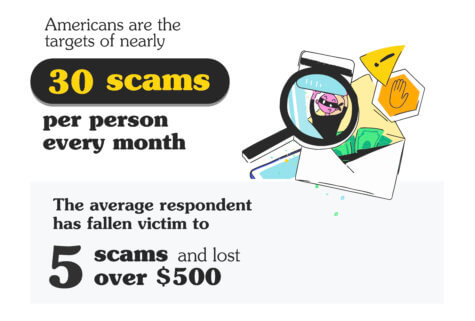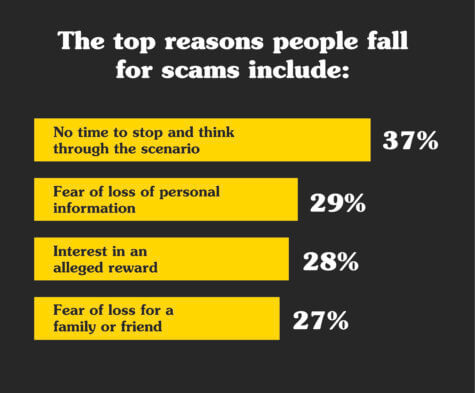NEW YORK — Does a robocall or bogus spam email ever catch you off guard? Don’t feel bad, a new study finds scammers may be targeting you more than you realize. Americans are the targets of nearly 30 scams a month.
From 10 email scams, nine phone calls, and eight fishy texts a month – the survey of 2,000 American millennials and baby boomers finds the scamming crisis is running rampant.
Go phish
 Two in five respondents reportedly receive upwards of 11 scam emails a month and 34 percent say they get scam phone calls more than 11 times a month. Baby boomers report an average of two more scam calls than millennials per month (10 vs. 8 calls, respectively).
Two in five respondents reportedly receive upwards of 11 scam emails a month and 34 percent say they get scam phone calls more than 11 times a month. Baby boomers report an average of two more scam calls than millennials per month (10 vs. 8 calls, respectively).
Conducted by OnePoll on behalf of Scam Spotter, a platform created by Cybercrime Support Network (CSN) with support from Google, the survey finds that 46 percent of respondents have lost money due to a scam. The average respondent has fallen victim to five scams over their lifetime where they’ve lost an average of over $500.
Respondents were also asked about the most ridiculous scam attempts they’ve seen. Claims of a warrant out for their arrest in a state they’ve never been to (34%), a non-existent relative in prison (30%), and attempts to pay their taxes in gift cards (26%) top the list. One in five respondents say they were tipped off when a scammer poorly impersonated a friend or relative.
Why do people fall for frauds?
After all of these close calls, the question remains of why so many people fall for scams. The poll finds 37 percent attribute it to not having the time to stop and think through the scenario the scammer is throwing at them.
Nearly three in 10 respondents also cited fearing a loss of their personal information and 27 percent feared a family member or friend would lose their information. The most common payment methods these scammers target include a credit or debit card (38%), followed by digital wallets (34%) and gift cards (31%).
“Scammers love gift cards because they are untraceable and there’s no way to recover the money once a scammer has the card details,” says Jenny Grounds, CMO of Cybercrime Support Network, in a statement. “At CSN and through Scam Spotter, our mission is to educate people about these scams so that they can be their best first line of defense against scammers.”
Scamming the scammer
 After the seemingly constant bombardment of scammers, 73 percent of respondents admit they’ve tried to expose their would-be scammers. Thirty-seven percent of respondents have played into the scam, acted like they don’t understand how to get the scammer the money, and talked in circles with the scammer so they’d give up.
After the seemingly constant bombardment of scammers, 73 percent of respondents admit they’ve tried to expose their would-be scammers. Thirty-seven percent of respondents have played into the scam, acted like they don’t understand how to get the scammer the money, and talked in circles with the scammer so they’d give up.
Other ways respondents have exposed their would-be scammers included poking holes in their phony scenario (35%) or by trying to get more information about the scammer so they can report them (28%). Nearly a quarter of Americans (23%) have even told the crook they were on TV for a news story in order to scare them off.
After being the target of an unsuccessful scam, the top action respondents took was warning as many friends and family members as they could about the attempted scam (42%). Millennial respondents are the most likely people to do this, with 65 percent saying they worry about older relatives falling for scams and 85 percent starting conversations to warn their elders about these scams.
“As the fraud industry surpasses $3.3 billion, it’s clear that scams are becoming more complex and adults of all ages are targets,” says Grounds. “The best way to combat scams is by talking about them, which is why we’ve launched an awareness campaign and PSA through scamspotter.org to spark conversation amongst families and warn people that if someone asks to solve a problem using gift cards, it’s a scam.”
